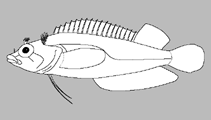Haptoclinus dropi Baldwin & Robertson, 2013
Four-fin blenny
Ajouter votre observation dans Fish Watcher
| Native range |

|
| This map was computer-generated and has not yet been reviewed. |
| Haptoclinus dropi AquaMaps Data sources: GBIF OBIS |
Envoyez vos Photos et vidéos
Images GoogleNo image available for this species;
drawing shows typical species in Labrisomidae.
Images GoogleNo image available for this species;
drawing shows typical species in Labrisomidae.
Classification / Names Noms communs | Synonymes | Catalog of Fishes(Genre, Espèce) | ITIS | CoL | WoRMS | Cloffa
> Blenniiformes (Blennies) > Labrisomidae (Labrisomids)
Etymology: dropi: Named for the Smithsonian Institution’s Deep Reef Observation Project (DROP); noun in the genitive case.
Eponymy: Not an eponym but named for the Smithsonian Institution’s Deep Reef Observation Project (DROP). (Ref. 128868), visit book page.
Etymology: dropi: Named for the Smithsonian Institution’s Deep Reef Observation Project (DROP); noun in the genitive case.
Eponymy: Not an eponym but named for the Smithsonian Institution’s Deep Reef Observation Project (DROP). (Ref. 128868), visit book page.
Environment: milieu / climate zone / depth range / distribution range Écologie
marin récifal; profondeur 157 - 167 m (Ref. 93751). Tropical
Distribution Pays | Zones FAO | Écosystèmes | Occurrences | Point map | Introductions | Faunafri
Western Central Atlantic: southern Caribbean, Curaçao.
Taille / Poids / Âge
Maturity: Lm ? range ? - ? cm
Max length : 2.2 cm SL (female)
Max length : 2.2 cm SL (female)
Description synthétique Clés d'identification | Morphologie | Morphométrie
Épines dorsales (Total) : 12; Rayons mous dorsaux (Total) : 12; Épines anales: 2; Rayons mous anaux: 19; Vertèbres: 36. This species is distinguished from its congener (apectolophus) by the following set of characters: DL III-I-XIII,12; A 19; pectoral-fin rays 12; precaudal vertebrae 12; first dorsal-fin spine longer than second dorsal-fin spine; no scales; posterior nostril without fleshy flap; trunk, dorsal and anal fins with spotted pigment pattern in preservative (Ref. 93751).
Cross section: oval.
Cross section: oval.
Life cycle and mating behavior Maturité | Reproduction | Frai | Œufs | Fécondité | Larves
Référence principale
Upload your references | Références | Coordinateur : Williams, Jeffrey T. | Collaborateurs
Baldwin, C. and R. Robertson, 2013. A new Haptoclinus blenny (Teleostei, Labrisomidae) from deep reefs off Curaçao, southern Caribbean, with comments on relationships of the genus. ZooKeys 306(2013):71-81. (Ref. 93751)
Statut dans la liste rouge de l'IUCN (Ref. 130435: Version 2024-2)
Données manquantes (DD) ; Date assessed: 01 May 2013
CITES
Not Evaluated
Menace pour l'homme
Harmless
Utilisations par l'homme
FAO - Publication: search | FishSource |
Plus d'informations
Trophic ecology
Food items (preys)
Composition du régime alimentaire
Consommation alimentaire
Food rations
Prédateurs
Food items (preys)
Composition du régime alimentaire
Consommation alimentaire
Food rations
Prédateurs
Ecology
Écologie
Écologie
Population dynamics
Paramètres de croissance
Max. ages / sizes
Length-weight rel.
Length-length rel.
Fréquences de longueurs
Mass conversion
Recrutement
Abondance
Paramètres de croissance
Max. ages / sizes
Length-weight rel.
Length-length rel.
Fréquences de longueurs
Mass conversion
Recrutement
Abondance
Life cycle
Reproduction
Maturité
Maturity/Gills rel.
Fécondité
Frai
Spawning aggregations
Œufs
Développement de l'œuf
Larves
Dynamique des populations larvaires
Reproduction
Maturité
Maturity/Gills rel.
Fécondité
Frai
Spawning aggregations
Œufs
Développement de l'œuf
Larves
Dynamique des populations larvaires
Anatomy
Surface branchiale
Brain
Otolith
Surface branchiale
Brain
Otolith
Physiology
Body composition
Nutrients
Consommation d'oxygène
Type de nage
Vitesse de nage
Visual pigments
Fish sound
Diseases & Parasites
Toxicity (LC50s)
Body composition
Nutrients
Consommation d'oxygène
Type de nage
Vitesse de nage
Visual pigments
Fish sound
Diseases & Parasites
Toxicity (LC50s)
Genetics
Génétique
Heterozygosity
Héritabilité
Génétique
Heterozygosity
Héritabilité
Human related
Aquaculture systems
Profils d'aquaculture
Souches
Ciguatera cases
Stamps, coins, misc.
Aquaculture systems
Profils d'aquaculture
Souches
Ciguatera cases
Stamps, coins, misc.
Outils
E-book | Guide de terrain | Générateur de fréquences de longueur | Outil de dynamique de population | Carte par point | Classification Tree
| Catch-MSY |
Articles particuliers
Télécharger en XML
Sources Internet
AFORO (otoliths) | Aquatic Commons | BHL | Cloffa | BOLDSystems | Websites from users | FishWatcher | CISTI | Catalog of Fishes: Genre, Espèce | DiscoverLife | ECOTOX | FAO - Publication: search | Faunafri | Fishipedia | Fishtrace | GenBank: génôme, nucléotide | GloBI | Google Books | Google Scholar | Google | IGFA World Record | MitoFish | Otolith Atlas of Taiwan Fishes | PubMed | Reef Life Survey | Socotra Atlas | Arbre de Vie | Wikipedia: aller à, chercher | World Records Freshwater Fishing | Zoobank | Zoological Record
Estimates based on models
Phylogenetic diversity index (Ref. 82804): PD50 = 0.7500 [Uniqueness, from 0.5 = low to 2.0 = high].
Bayesian length-weight: a=0.01000 (0.00244 - 0.04107), b=3.04 (2.81 - 3.27), in cm total length, based on all LWR estimates for this body shape (Ref. 93245).
Niveau trophique (Ref. 69278): 3.1 ±0.3 se; based on size and trophs of closest relatives
Fishing Vulnerability (Ref. 59153): Low vulnerability (10 of 100).




